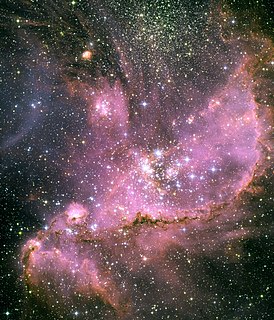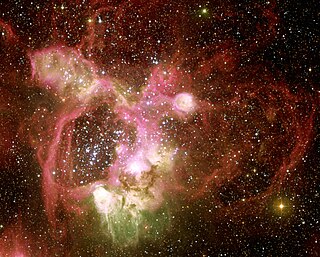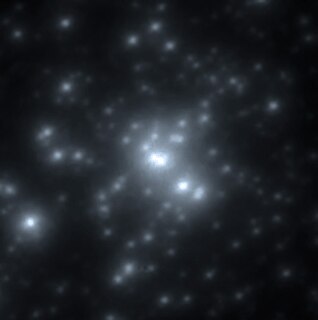Related Research Articles

A globular cluster is a spherical collection of stars. Globular clusters are very tightly bound by gravity, giving them their spherical shapes and high concentrations of stars toward their centers. Their name is derived from Latin globulus—a small sphere. Globular clusters are occasionally known simply as globulars.

An open cluster is a type of star cluster made of up to a few thousand stars that were formed from the same giant molecular cloud and have roughly the same age. More than 1,100 open clusters have been discovered within the Milky Way Galaxy, and many more are thought to exist. They are loosely bound by mutual gravitational attraction and become disrupted by close encounters with other clusters and clouds of gas as they orbit the galactic center. This can result in a migration to the main body of the galaxy and a loss of cluster members through internal close encounters. Open clusters generally survive for a few hundred million years, with the most massive ones surviving for a few billion years. In contrast, the more massive globular clusters of stars exert a stronger gravitational attraction on their members, and can survive for longer. Open clusters have been found only in spiral and irregular galaxies, in which active star formation is occurring.

Star clusters are large groups of stars. Two main types of star clusters can be distinguished: globular clusters are tight groups of hundreds to millions of old stars which are gravitationally bound, while open clusters are more loosely clustered groups of stars, generally containing fewer than a few hundred members, and are often very young. Open clusters become disrupted over time by the gravitational influence of giant molecular clouds as they move through the galaxy, but cluster members will continue to move in broadly the same direction through space even though they are no longer gravitationally bound; they are then known as a stellar association, sometimes also referred to as a moving group.

The Large Magellanic Cloud (LMC) is a satellite galaxy of the Milky Way. At a distance of around 50 kiloparsecs (≈160,000 light-years), the LMC is the second or third closest galaxy to the Milky Way, after the Sagittarius Dwarf Spheroidal (~16 kpc) and the possible dwarf irregular galaxy known as the Canis Major Overdensity. Based on readily visible stars and a mass of approximately 10 billion solar masses, the diameter of the LMC is about 14,000 light-years (4.3 kpc). It is roughly a hundredth as massive as the Milky Way and is the fourth largest galaxy in the Local Group, after the Andromeda Galaxy (M31), the Milky Way, and the Triangulum Galaxy (M33).

The Magellanic Clouds are two irregular dwarf galaxies visible in the Southern Celestial Hemisphere; they are members of the Local Group and are orbiting the Milky Way galaxy. Because both show signs of a bar structure, they are often reclassified as Magellanic spiral galaxies. The two galaxies are:

The Small Magellanic Cloud (SMC), or Nubecula Minor, is a dwarf galaxy near the Milky Way. Classified as a dwarf irregular galaxy, the SMC has a diameter of about 7,000 light-years, contains several hundred million stars, and has a total mass of approximately 7 billion solar masses. The SMC contains a central bar structure, and astronomers speculate that it was once a barred spiral galaxy that was disrupted by the Milky Way to become somewhat irregular. At a distance of about 200,000 light-years, the SMC is among the nearest intergalactic neighbors of the Milky Way and is one of the most distant objects visible to the naked eye.

The European Organisation for Astronomical Research in the Southern Hemisphere, commonly referred to as the European Southern Observatory (ESO), is a 16-nation intergovernmental research organisation for ground-based astronomy. Created in 1962, ESO has provided astronomers with state-of-the-art research facilities and access to the southern sky. The organisation employs about 730 staff members and receives annual member state contributions of approximately €162 million. Its observatories are located in northern Chile.

The Tarantula Nebula is an H II region in the Large Magellanic Cloud (LMC), from the Solar System's perspective forming its south-east corner.

Knut Emil Lundmark, was a Swedish astronomer, professor of astronomy and head of the observatory at Lund University from 1929 to 1955.

NGC 1850 is a double cluster and a super star cluster in the Dorado constellation, located in the northwest part of the bar of the Large Magellanic Cloud, at a distance of 168 kly (51.5 kpc) from the Sun. It was discovered by Scottish astronomer James Dunlop in 1826.

Westerlund 2 is an obscured compact young star cluster in the Milky Way, with an estimated age of about one or two million years. It contains some of the hottest, brightest, and most massive stars known. The cluster resides inside a stellar breeding ground known as Gum 29, located 20,000 light-years away in the constellation Carina. It is half a degree from the naked eye Cepheid variable V399 Carinae.

NGC 346 is a young open cluster of stars with associated nebula located in the Small Magellanic Cloud (SMC) that appears in the southern constellation of Tucana. It was discovered August 1, 1826 by Scottish astronomer James Dunlop. J. L. E. Dreyer described it as, "bright, large, very irregular figure, much brighter middle similar to double star, mottled but not resolved". On the outskirts of the cluster is the multiple star system HD 5980, one of the brightest stars in the SMC.
In astronomy, stellar kinematics is the observational study or measurement of the kinematics or motions of stars through space.
Víctor Manuel Blanco was a Puerto Rican astronomer who in 1959 discovered Blanco 1, a galactic cluster. Blanco was the second Director of the Cerro Tololo Inter-American Observatory in Chile, which had the largest telescope in the Southern Hemisphere at the time. In 1995, the 4-meter telescope was dedicated in his honor and named the Víctor M. Blanco Telescope; it is also known as the "Blanco 4m."
Jeremy R. Mould is an Australian astronomer currently at the Centre for Astrophysics and Supercomputing at Swinburne University of Technology. Mould was previously Director of the Research School of Astronomy and Astrophysics at the Australian National University and the American National Optical Astronomy Observatory. He is an Honorary Professorial Fellow, at the University of Melbourne.

N44 is an emission nebula with superbubble structure located in the Large Magellanic Cloud, a satellite galaxy of the Milky Way in the constellation Dorado. Originally catalogued in Karl Henize's "Catalogue of H-alpha emission stars and nebulae in the Magellanic Clouds" of 1956, it is approximately 1,000 light-years wide and 160,000-170,000 light-years distant. N44 has a smaller bubble structure inside known as N44F. The superbubble structure of N44 itself is shaped by the radiation pressure of a 40-star group located near its center; the stars are blue-white, very luminous, and incredibly powerful. N44F has been shaped in a similar manner; it has a hot, massive central star with an unusually powerful stellar wind that moves at 7 million kilometers per hour. This is because it loses material at 100 million times the rate of the Sun, or approximately 1,000,000,000,000,000 tons per year. However, varying density in the N44 nebula has caused the formation of several dust pillars that may conceal star formation. This variable density is likely caused by previous supernovae in the vicinity of N44; many of the stars that have shaped it will eventually also end as supernovae. The past effects of supernovae are also confirmed by the fact that N44 emits x-rays.

R136a2 is a Wolf-Rayet star residing near the center of the R136, the central concentration of stars of the large NGC 2070 open cluster in the Tarantula Nebula, a massive H II region in the Large Magellanic Cloud which is a nearby satellite galaxy of the Milky Way. It has one of the highest confirmed masses and luminosities of any known star, at about 187 M☉ and 5.6 million L☉ respectively.

Westerlund 1-26 or Wd 1-26 is a red supergiant within the outskirts of the Westerlund 1 super star cluster. It is one of the largest known stars discovered so far although its radius is uncertain but is calculated to be 1,165–1,221 solar radii (810,000,000–849,000,000 km; 5.42–5.68 au), with a possible but very unlikely upper estimate of 2,519 solar radii (1.752×109 km; 11.71 au), corresponding to a volume between 1.58 and 16 billion times bigger than the Sun. Assuming the upper estimate is correct, if placed at the center of the Solar System, its photosphere would engulf the orbit of Jupiter.
Johanna Sofia Nikolina Feltzing is a Swedish astronomer and Professor of Astronomy at Lund University since 2011. She completed her PhD at Uppsala University in 1996, publishing a dissertation about the chemical evolution of the Milky Way. Feltzing was the first woman to complete a PhD in astronomy at Uppsala, and the tenth in Sweden. She was a postdoctoral researcher at Royal Greenwich Observatory and the Institute of Astronomy, Cambridge at Cambridge University from 1996 to 1998. In 1998 she moved to Lund Observatory.
References
- 1 2 3 4 "Bengt Westerlund (1921-2008)". Uppsala University. Archived from the original on 10 May 2015. Retrieved 9 May 2015.
- 1 2 3 4 "In Memoriam: Bengt Westerlund" (PDF). ESO.org. Archived from the original (PDF) on 10 May 2015. Retrieved 9 May 2015.
- ↑ Archinal, Brent; Hynes, Steven (2003). Star Clusters. Willmann-Bell. p. 195. ISBN 0943396808.